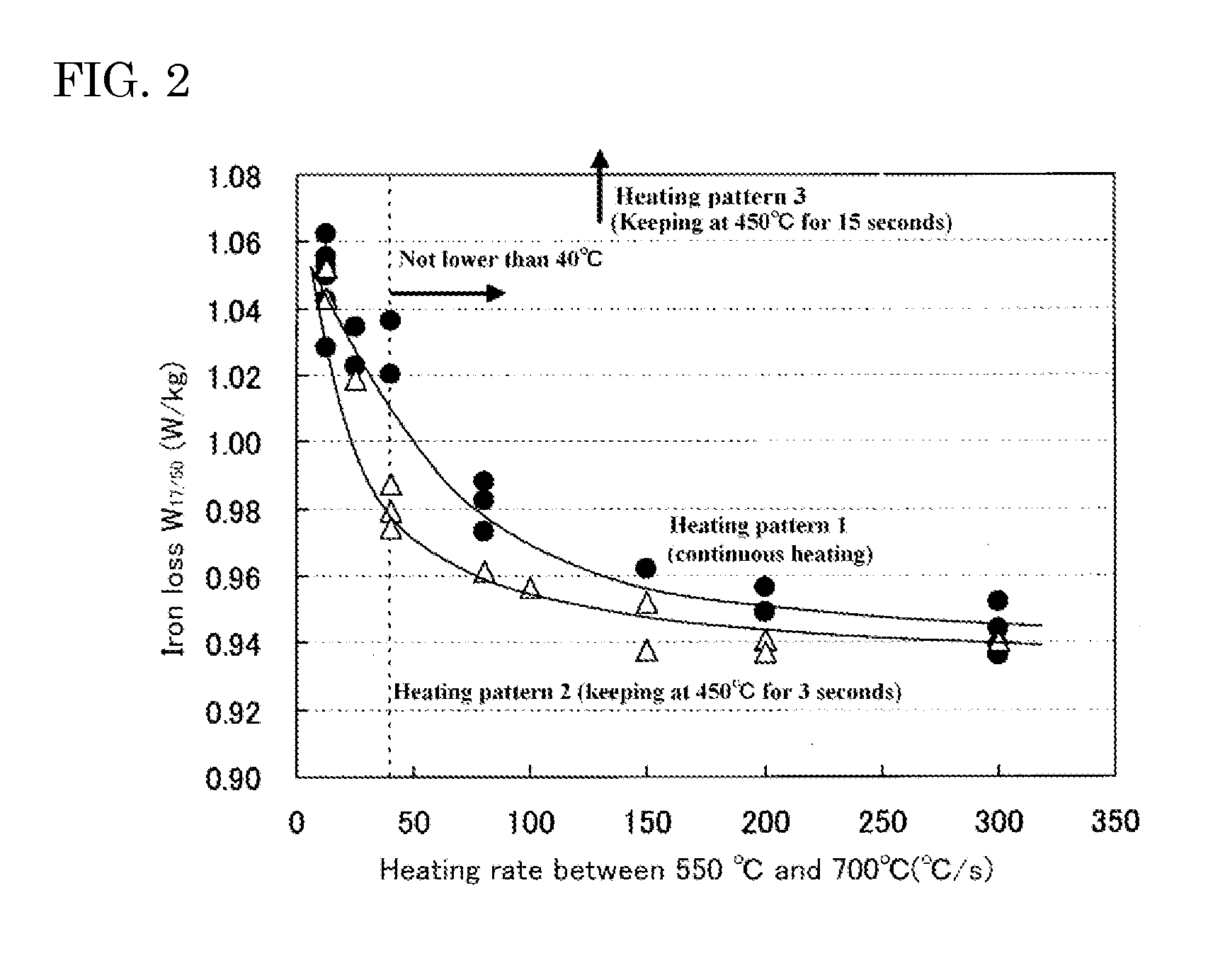Method for producing grain-oriented electrical steel sheet
a technology of electrical steel and grain-oriented steel, which is applied in the direction of heat treatment apparatus, magnetic bodies, furnaces, etc., can solve the problems of reducing dislocation density and insufficient recrystallization, and achieves easy and stably obtaining grain-oriented electrical steel sheets, low iron loss properties, and high heating rate
- Summary
- Abstract
- Description
- Claims
- Application Information
AI Technical Summary
Benefits of technology
Problems solved by technology
Method used
Image
Examples
example 1
[0059]A steel slab containing C: 0.06 mass %, Si: 3.3 mass %, Mn: 0.08 mass %, S: 0.001 mass %, Al: 0.002 mass %, N: 0.002 mass %, Cu: 0.05 mass % and Sb: 0.01 mass % is heated at 1100° C. for 30 minutes and hot rolled to obtain a hot rolled sheet having a thickness of 2.2 mm, which is subjected to an annealing at 1000° C. for 1 minute and cold rolled to obtain a cold rolled coil having a final thickness of 0.23 mm.
[0060]A sample of L: 300 mm×C: 100 mm is taken out from a central portion of the cold rolled coil thus obtained in longitudinal and widthwise directions and subjected to primary recrystallization annealing combined with decarburization annealing with an induction heating apparatus in a laboratory. In the primary recrystallization annealing, the heating is performed by two kinds of patterns as shown in Table 1, i.e. a pattern of continuously heating from room temperature (RT) to 700° C. at a constant heating rate of 20˜300° C. / s (No. 1, 2, 9, 11, 13) and a pattern of heati...
example 2
[0064]A steel slab having a chemical composition shown in Table 2 is heated at 1200° C. for 20 minutes and hot rolled to obtain a hot rolled sheet of 2.0 mm in thickness, which is annealed at 1000° C. for 1 minute, subjected to primary cold rolling to a thickness of 1.5 mm, annealed at 1100° C. for 2 minutes and subjected to secondary cold rolling to obtain a cold rolled sheet having a final thickness of 0.23 mm and thereafter subjected to a magnetic domain subdividing treatment wherein linear grooves are formed on the steel sheet surface by electrolytic etching.
[0065]Then, the steel sheet is subjected to a primary recrystallization annealing combined with decarburization annealing wherein the sheet is heated from room temperature to 750° C. at various heating rates shown in Table 2 and heated from 750° C. to 840° at a heating rate of 10° C. / s and kept in a wet hydrogen atmosphere of PH2O / PH2=0.3 for 2 minutes, and coated with an aqueous slurry of an annealing separator composed mai...
example 3
[0067]A test piece of 150 mm in width is taken out from the hot rolled sheet No. 1 of Table 2 used in Example 2 and heated in a laboratory at 1150° C. for one-side edge portion of the width (30 mm ranging from the widthwise end portion) and at 1050° C. for the other portion for 2 minutes to coarsen crystal grains at the one-side edge portion of the steel sheet. This treatment supposes a case that the steel sheet is overheated due to deceleration or the like caused by some troubles in the threading through the annealing line, and considers that when a material having crystal grains coarsened at this stage is subjected to post process under the same conditions as in the normal material, poor secondary recrystallization is easily caused by a change in texture or grain size of primary recrystallized grains.
[0068]Then, the hot rolled sheet is cold-rolled to obtain a cold rolled sheet having a final thickness of 0.23 mm, which is heated from room temperature to 750° at a heating rate of 1...
PUM
| Property | Measurement | Unit |
|---|---|---|
| temperature | aaaaa | aaaaa |
| temperature | aaaaa | aaaaa |
| temperature | aaaaa | aaaaa |
Abstract
Description
Claims
Application Information
 Login to View More
Login to View More - R&D
- Intellectual Property
- Life Sciences
- Materials
- Tech Scout
- Unparalleled Data Quality
- Higher Quality Content
- 60% Fewer Hallucinations
Browse by: Latest US Patents, China's latest patents, Technical Efficacy Thesaurus, Application Domain, Technology Topic, Popular Technical Reports.
© 2025 PatSnap. All rights reserved.Legal|Privacy policy|Modern Slavery Act Transparency Statement|Sitemap|About US| Contact US: help@patsnap.com



